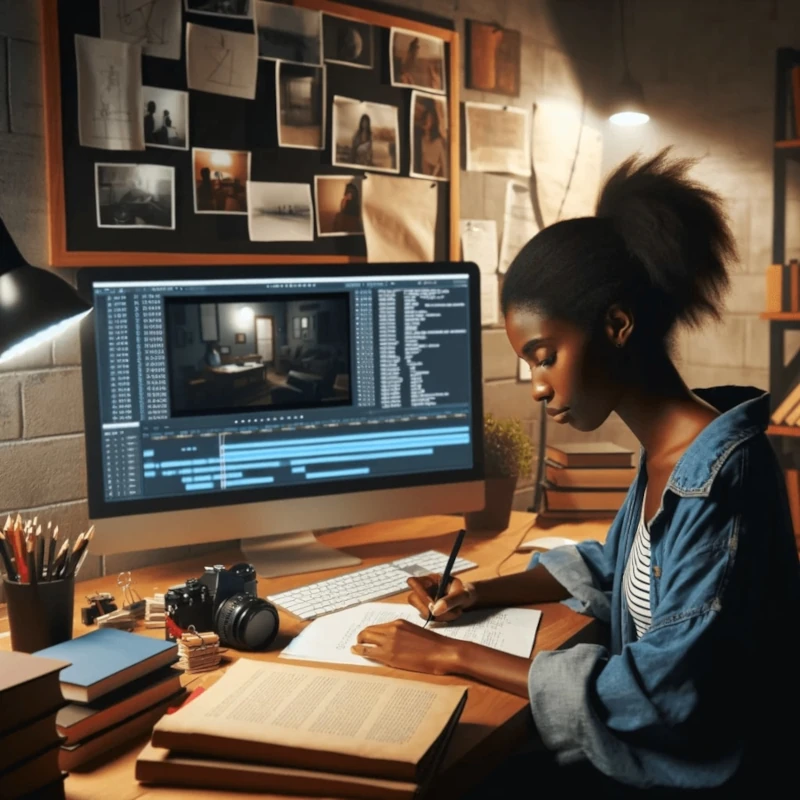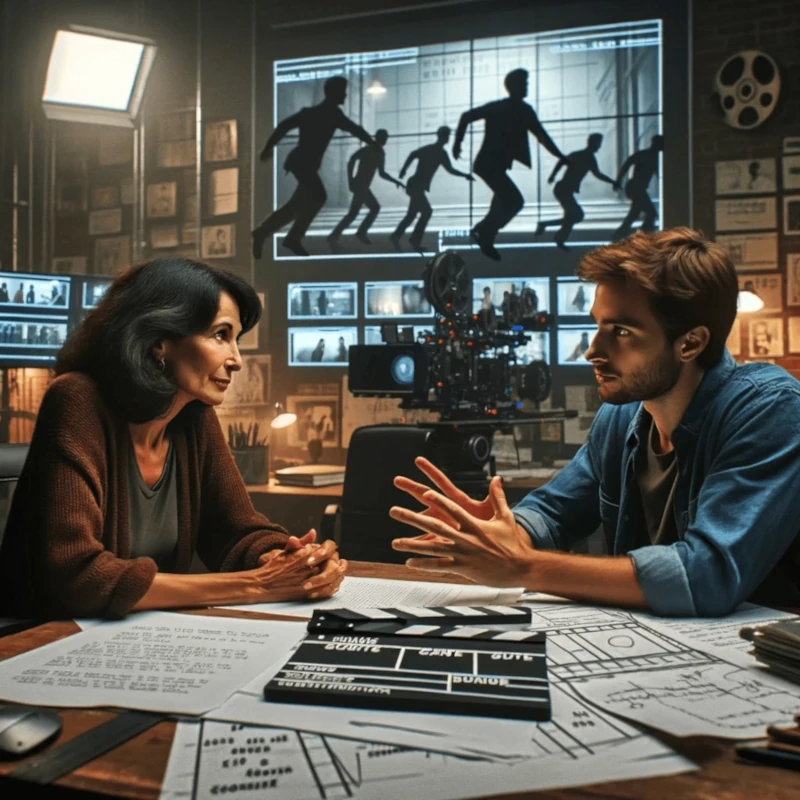Screenwriting is an art form that combines storytelling with visual imagination. At its core, a screenplay is a blueprint for a film, guiding directors, actors, and the entire production team through the narrative. However, one aspect often overlooked by aspiring screenwriters is the incorporation of shots into the script. While dialogue and action drive the narrative, the inclusion of specific shots can elevate a screenplay from a mere narrative to a vivid visual experience.
Unlock the power of visual storytelling in screenwriting with insights on integrating camera shots effectively into your scripts.
Key Takeaways
- Camera shots are crucial in visual storytelling.
- Different shots serve specific narrative purposes.
- Balance visuals with other script elements.
- Examples from iconic films illustrate effective use.
Types of Shots and Their Impact on Storytelling
In screenwriting, the choice of shots plays a pivotal role in storytelling. Each type of shot serves a specific purpose and can significantly influence the viewer’s understanding and emotional response to a scene. Let’s explore some of the common shots of screenwriting used in filmmaking:
1. Wide Shot (WS)
Wide shots are essential for establishing the setting and context of a scene. They allow the audience to see the environment around the characters, providing a sense of place and scale. In screenwriting, specifying a wide shot can help set the scene’s tone and give the director a clear idea of the intended scope.
2. Medium Shot (MS)
The medium shot typically frames characters from the waist up. This shot is versatile, balancing the character with their surroundings. It’s often used for dialogue scenes, as it allows for a clear view of the characters’ expressions and body language while keeping them in context with their environment.
3. Close-Up (CU)
Close-ups are powerful for highlighting a character’s emotions or reactions. By focusing tightly on a character’s face, a close-up can convey subtle feelings and thoughts, adding depth to the character and intensity to the scene.
4. Over-the-Shoulder Shot (OTS)
This shot shows the back of one character’s shoulder and head while focusing on another character. It’s commonly used in dialogue scenes to create a sense of interaction and perspective between characters.
5. Point-of-View Shot (POV)
A POV shot shows what a character is looking at, effectively putting the audience in the character’s shoes. It’s a great way to directly convey a character’s perspective and experience to the audience.
Incorporating these shots into your script can enhance the visual storytelling and provide clear direction for how you envision the scene. The key is to include shots that are essential for conveying the story or emotion of the scene.
How do camera shots enhance a screenplay?
Camera shots in a screenplay serve as pivotal storytelling tools, dictating audience perspective and enhancing emotional impact. They range from wide shots establishing context to close-ups revealing character emotions, significantly contributing to the narrative and visual experience.
How to Write Shots in a Script
Writing shots in a script is a blend of technical know-how and creative vision. It’s not just about dictating the camera’s movement but about enhancing the narrative. Here are some steps and tips for effectively writing shots into your screenplay:

1. Understand the Basics of Formatting
Screenplay formatting is crucial. When writing a shot, it should be in all caps (e.g., CLOSE-UP ON JOHN’S FACE). This signals to the reader that it’s a camera direction.
2. Use Shots Sparingly and Intentionally
Shots should be used to emphasize key moments in your script, not to micromanage the director’s vision. Think of them as tools to highlight important elements or emotions in a scene.
3. Be Descriptive, But Concise
Your shot descriptions should be vivid enough to paint a picture but concise enough not to disrupt the flow of the script. For example, “WIDE SHOT of the bustling street, alive with the morning rush.”
4. Consider the Impact of the Shot
Before adding a shot, consider how it contributes to the scene. Does it add tension, reveal character, or provide necessary information? If it doesn’t serve a purpose, it’s probably best left out.
5. Collaborate with Directors and Cinematographers
If possible, discuss your vision with the director and cinematographer. They can provide valuable insights into how your written shots can be translated onto the screen.
Writing shots into a script is about finding the right balance. It requires an understanding of film language and how visuals can complement your storytelling. With practice, you’ll learn to use shots as a powerful tool to bring your script to life.
Learn More: What is Post-Production in Filmmaking
Screenwriting camera directions
Quentin Tarantino’s ‘Pulp Fiction’ stands as a masterclass in the use of camera directions to enhance storytelling. Tarantino’s screenplay is known for its distinctive style, combining sharp dialogue with innovative visual techniques. Let’s delve into how camera directions in ‘Pulp Fiction’ contribute to its narrative impact.
Tarantino often uses unconventional camera angles to create a sense of tension and unpredictability. For instance, low-angle shots of characters like Jules and Vincent make them appear more dominant and intimidating. The use of camera directions in ‘Pulp Fiction’ demonstrates how a screenplay can transcend mere words on a page, becoming a visual guide that contributes significantly to the film’s unique style and storytelling.
Balancing Script and Visuals
One of the key challenges in screenwriting is achieving a balance between the script elements — dialogue, action descriptions, and camera shots. This balance is essential for crafting a screenplay that is both engaging to read and effective as a visual blueprint for a film. Here’s how to find that equilibrium:

1. Prioritize Story and Character Development
Always ensure that the story and character development are at the forefront. Camera shots should serve to enhance these elements, not overshadow them.
2. Use Visual Descriptions to Complement Dialogue
Visuals and dialogue should work in tandem. While dialogue conveys characters’ thoughts and feelings, visual descriptions can provide context and subtext, enriching the narrative.
3. Avoid Over-Directing the Camera
Screenwriters should resist the temptation to direct every camera move. Leave room for the director’s creative input and the cinematographer’s expertise in visual storytelling.
Achieving a balance between script and visuals is crucial for a screenplay’s success. It’s about creating a cohesive narrative that seamlessly integrates storytelling with visual elements, resulting in a compelling film.
Examples of Shot Incorporation in Scripts
Studying famous screenplays can provide invaluable lessons in how to effectively incorporate shots. Let’s examine excerpts from classic screenplays to understand how master screenwriters use camera shots to enhance their storytelling.
1. The Godfather
This screenplay is a prime example of using shots to build tension and atmosphere. For instance, the use of close-ups in the iconic opening scene conveys the intensity of emotions and sets the tone for the film.
2. Inception
Nolan’s screenplay for ‘Inception’ demonstrates the use of innovative shots to depict the complex, layered world of dreams. The shifting perspectives and imaginative camera movements help convey the film’s surreal quality.
3. Casablanca
The classic film ‘Casablanca’ showcases the use of wide shots to establish the exotic, war-torn setting, while close-ups are used to focus on the characters’ nuanced emotions and interactions.
These screenplays illustrate the diverse ways shots can be integrated into a script. Whether it’s to create mood, focus on character details, or bring out thematic elements, the effective use of shots can significantly elevate the storytelling in a screenplay.
Best Practices for Aspiring Screenwriters
As an aspiring screenwriter, mastering the art of incorporating shots into your script can be a game-changer. Here are some best practices to keep in mind:
1. Understand the Language of Film
Familiarize yourself with different types of shots and their effects on storytelling. Knowing when and how to use them is key to effective visual storytelling.
2. Enhance, Don’t Dictate
Use shots to enhance your narrative. Avoid over-directing and allow some flexibility for the director and cinematographer to interpret your script.
3. Be Purposeful with Your Choices
Every shot you write should have a clear purpose, whether it’s to establish setting, build character, or drive the plot forward.
4. Collaborate and Learn
Screenwriting is a collaborative process. Be open to feedback from directors, cinematographers, and other professionals. Their insights can help refine your approach to incorporating shots.
Remember, the goal is to create a script that vividly conveys your story and vision, using shots as a tool to bring your narrative to life on screen.
About RFM
RFM is a web-based video, TV, and film production management software that offers various features for professionals in the entertainment industry. It allows users to write professional project briefs and descriptions, talent, and actor showcases, visualize scenes with shot lists, media sharing and manage various aspects of production, including call sheets, shooting schedules, and script breakdowns. RFM is designed to help teams collaborate more effectively during the production process, making it a valuable tool for filmmakers, photographers, and video production companies